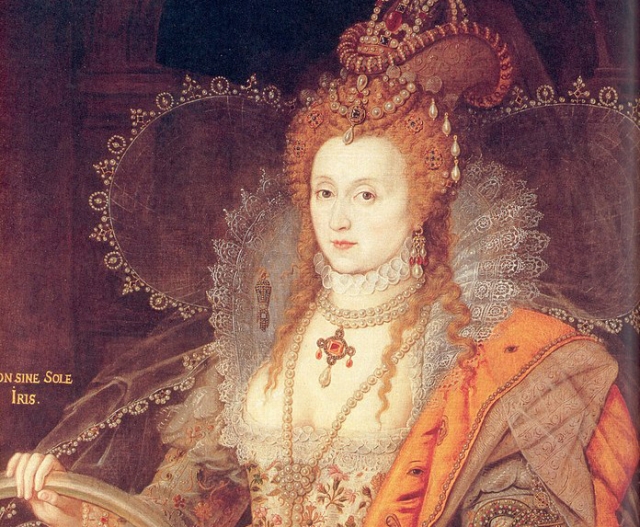Analysing Portraits
Student Guides

Portraits of Elizabeth I
|
This resource is free to everyone. For access to a wealth of other online resources from podcasts to articles and publications, plus support and advice though our “How To”, examination and transition to university guides and careers resources, join the Historical Association today |
The Elizabeth I Rainbow Portrait
- See an image of the Rainbow portrait (on display at Hatfield House) (Wikimedia Commons)
This portrait was clearly commissioned by either Elizabeth herself or an advisor. The majesty and symbolism in this portrait is designed to dazzle, inspire and intimidate various audiences.
This is also a 'secondary' image. There is no way that an artist painted a posing Elizabeth clutching a rainbow. More seriously, this portrait was painted in or around 1600 and Elizabeth would only live for three more years, putting her in her late sixties. Yet the queen's face is ageless, beautiful and perfect. This painter was either working from a basic model of the queen's face or looking at an older portrait to project only her beauty and majesty, like a Tudor version of magazines air-brushing pictures of celebrities!
To put this portrait into the context of the time, the Queen's forces had successfully defeated King Phillip II's Armada 12 years earlier, an astounding victory for the English. Meanwhile, Elizabeth has declared her power to agree or disagree to anything Parliament does, and the Irish Rebellion is soon to be quashed. Elizabeth has remained married only to her people and the Church of England grows stronger. This is the golden age of Elizabethan England, the "good times" so far removed from the broken country she inherited four decades before.
This ‘rainbow portrait' of Elizabeth is riddled with symbols:
- One not so subtle is the eyes and ear embroidered into her dress, probably a symbol that she sees and hears all. Who could doubt that with all the rebellions, plots and conspiracies she had survived?
- Elizabeth is being shown as wise, as her sleeve possesses the most cunning creature, the snake.
- She is also dripping with jewels and fine fabric, depicting her majesty, splendour and wealth.
- The beautiful crown on her head is a symbol of the monarchy. Her portraits have long since passed the time when they needed to show she was the rightful queen; Elizabeth is the monarch.
- She is also wearing pearls, a symbol of virginity.
- In her hand she holds a rainbow, a symbol of peace; she possesses peace.
- Another common symbol of monarchy (and indeed life) is the symbol of the sun. Without the sun, there can be no rainbow, and since Elizabeth holds the rainbow, what else can be concluded except that she is the sun (the Latin inscription implies as much) Elizabeth is the sun, and the crown.
Overall, the purpose of this portrait is clear: to show the power and majesty of Elizabeth.
|
Symbol |
Meaning |
|
Tudor rose, Portcullis |
Tudor monarchs |
|
Crown, sceptre, ermine |
Monarchy |
|
Papers held in hand |
Person involved in important business |
|
Scholar's cap |
Clever/well educated |
|
Velvets/ gold/jewels and furs |
Indicate wealth |
|
Pearls, Moons |
Virginity |
|
Flowers |
Youth |
|
Phoenix rising |
Purity/virginity and god-like status |
|
Pelican |
Monarch sacrificing herself to the people |
|
Sieve |
Virginity |
|
Globe |
Imperial ambitions |
|
Ermine Fox |
Virginity |
|
Sword of State |
Justice |
|
Sun / Bright skies |
Bringer of peace and plenty |
|
Storm clouds |
The sitter drives them away |
|
Cornucopia |
Brings food in abundance |
|
Gloves |
Elegance |
|
Dogs |
Faithfulness |
|
Snakes |
Cunning |
The Armada Portrait of Elizabeth I
- See an image of the Armada Portrait (Wikimedia Commons)
|
Identity: |
The Armada Portrait |
|
Date/Authorship: |
c. 1588, Unknown |
|
Primary or secondary: |
Primary |
|
Context:
|
|
|
Purpose:
|
|
|
Symbols/Allusions: |
Pearls, Sun, Armada, Victory, Globe, Americas, Crown, Rich fabric, Fan |
This portrait of Elizabeth I is commonly known as the Armada Portrait. Elizabeth I sits richly dressed, as a battle commences behind her. The painter has clearly cast Elizabeth in an extremely attractive light, alluding to victory, majesty, conquest and purity in the painting. This portrait is an excellent example of Elizabeth using her portrait as propaganda. The context is the pivotal, glorious pinnacle of the latter half of Elizabeth's reign.
- The naval battle behind her depicts Phillip II's Spanish Armada.
- Elizabeth's smiling, beautiful face is angled toward the window acknowledging England's sunny, glorious victory as she is a bringer of peace.
- Her hand rests on the globe, a symbol of imperialism and conquest. Specifically her hand rests on the Americas, appropriate as only a few years before areas of Virginia have been settled by Englishmen.
- Mary Queen of Scots had been recently executed as well as many conspiracies and rebellions being stopped. The crown is placed behind her as a symbol of the throne and power, in Elizabeth's possession and unchallenged in the portrait.
- Her rich dress speaks of her wealth and the gown is embroidered with small suns and pearls which are symbols of peace or plenty and purity, respectively.
- The ermine fan again speaks of her wealth and her chastity as well as her elegance as the monarch of the day.
Overall, this is a portrait of the Virgin Queen, married to her people, bringer of peace, master of the land and sea and defender of England as she reigns in a golden age for her kingdom.

